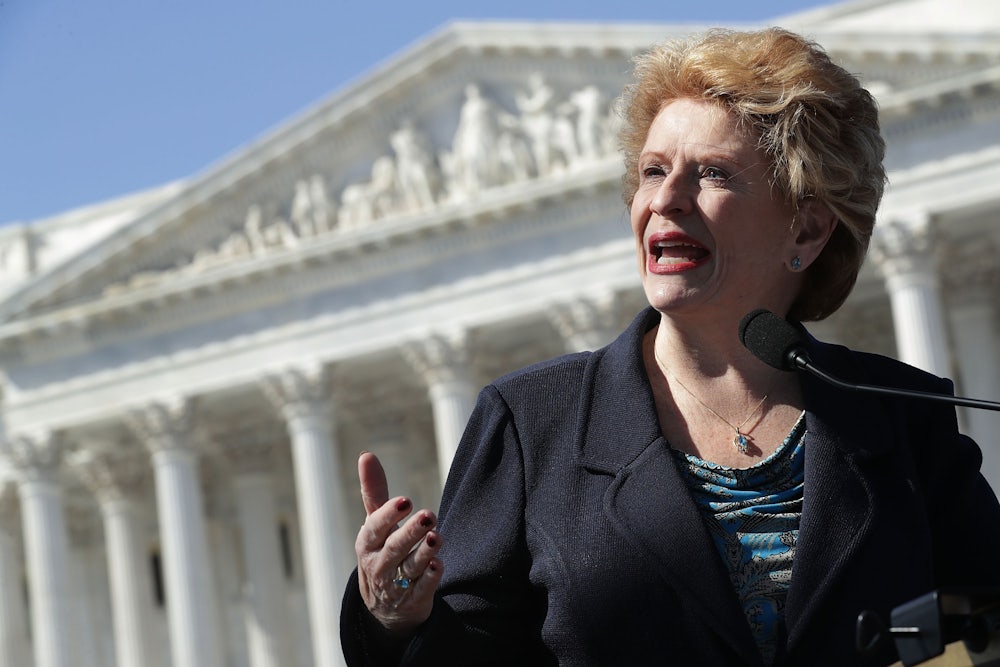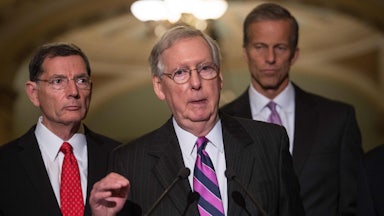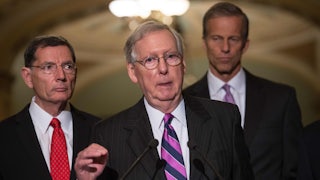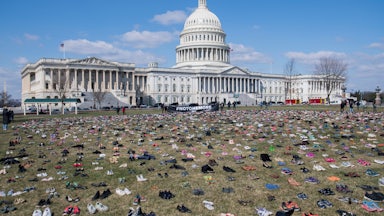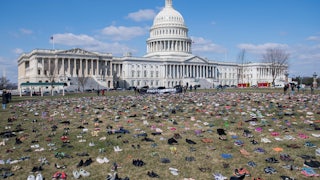Just days after President Biden signed the Bipartisan Safer Communities Act into law on June 25—the first major gun reform bill in three decades—a 21-year-old man with a semiautomatic assault-style rifle opened fire on a Fourth of July parade in the Chicago suburb of Highland Park, Illinois. He killed seven people and injured dozens more.
In a press conference after the shooting, Chicago Mayor Lori Lightfoot and Congresswoman Robin Kelly jumped to defend the president’s new reform. “You can literally walk across the border and, if you’ve got the money, you can buy military-grade weapons in any quantity that you want,” Lightfoot told a press gaggle. “And we see that happening every single day. The result is chaos and heartache in our streets.” But with this new law, she continued, “straw purchasing is now a federal crime. A critically important step. Gun trafficking is now a free-standing offense for the first time in federal law. It’s a crime to dispose of a gun to an individual that you know is prohibited from purchasing one,” she said.
The pair stopped short of contending that the legislation would have stopped the Highland Park gunman. The shooter purchased his guns legally in Illinois, a state with one of the strictest red-flag laws, despite police seizing 16 knives, a dagger, and a sword on one of two visits to his home.
Though the new law has been touted as the most expansive gun law passed in 30 years, the bar for gun reform is admittedly low. And while any progress on gun reform is laudable—and the law is likely to have some impact on gun access—the most important effects of the law will be felt elsewhere.
The Bipartisan Safer Communities Act has been framed as a gun reform, but perhaps a more fitting frame for the law is as the biggest single expansion of mental health care in American history—and the biggest expansion of Medicaid—with a few gun provisions.
To be sure, packaging the two together makes both gun reform and mental health advocates uncomfortable. The overwhelming majority of people with mental illness will never commit a violent act, though statistics show that they’re more likely to be victims. Tying mental illness with gun violence only stigmatizes it, reducing the likelihood that people who need care will get it. But gun rights activists see mental illness as a convenient distraction from the fundamental issue driving gun violence—the guns themselves.
Getting Republican participation on any gun reform, though, required that the two be linked. And any investment in our anemic mental health care system—whatever the pretext—should be welcomed. So the new law leverages Medicaid to vastly expand America’s mental health infrastructure through a system of Certified Community Behavioral Health Clinics, or CCBHCs, and school mental health investments.
I spoke with Michigan Democratic Senator Debbie Stabenow, the program’s architect, about how it happened. “The Republicans wanted to do something big on mental health. At the beginning, they wanted to do it at the exclusion of gun safety. We all said no. I mean, this is the issue of guns. But yes, of course, if you want to do something along with it on mental health,” Stabenow told me.
The law’s massive investment in mental health care didn’t just happen over the course of a few weeks. It was the product of nearly a decade of slow, methodical planning. Stabenow and GOP Missouri Senator Roy Blunt had been co-sponsors of the bill reauthorizing community health center funding—consistent federal dollars to support community clinics—when Stabenow proposed a similar approach to funding mental health care. Until that point, mental health clinics were forced to operate on grants that they simply couldn’t rely on. “On the behavioral health side of things, it [was] all stop and start. It [was] all grants that go away,” Stabenow told me.
She approached the Substance Abuse and Mental Health Services Administration, or SAMHSA, to design quality standards for the proposed mental health centers that would eventually become CCBHCs. These included 24-hour psychiatric crisis services and integration with physical health services. Stabenow and Blunt eventually co-sponsored a 2013 bill that was signed into law the next year by President Obama. The Excellence in Mental Health and Addiction Treatment Act initially allocated $1 billion to fund a demonstration project across 10 states. The program offers enhanced Medicaid reimbursements to cover 80 to 90 percent of the start-up and operating costs for CCBHCs meeting SAMHSA standards.
The results were impressive. According to Stabenow, there was a 60 percent reduction in jail bookings stemming from mental health crises, a 63 percent reduction in mental health emergency room visits, and a 41 percent decline in homelessness.
The act was reauthorized in 2021 as the need for community mental health service boomed with the Covid-19 pandemic. The program grew to have a footprint across 41 states with additional support in each of the Covid funding packages. And that was when the shootings in Uvalde, Texas, and Buffalo, New York, created the space for a full national expansion through the Bipartisan Safer Communities Act.
When I asked Stabenow if this was the biggest expansion of Medicaid since the Affordable Care Act, she said, “Yes, no question, and … it’s the biggest investment in mental health and addiction services ever.”
The irony of this moment is that Republicans have been working at the state and federal levels to restrict Medicaid, if not gut it entirely, since it was created as part of President Lyndon B. Johnson’s Great Society. And yet mental illness and substance use have devastated low-income white communities, Republican strongholds, over the past several decades. The need to actually invest in solutions in these communities coupled with the need to be seen to be responding to America’s growing gun violence epidemic is what ultimately spurred Republicans to invest in and expand a program they claim to hate.
But it’s also the fact that Democrats like Stabenow made it easier. “I didn’t lean in the beginning on emphasizing Medicaid,” she said. “I know it’s Medicaid. He knew it was Medicaid. But we just talked about what should be funding this.… I was trying to get them to see, look, we have this system that works, and everybody loves community health centers.”
The victory for mental health care, on its own, is—in the president’s favorite parlance—“a big fucking deal.” But there’s also an important lesson here for Democrats debating political strategy. “It’s interesting looking back on it, for me. It’s really a case study of doing something big but doing it in a step-by-step way where you could actually get it done,” Stabenow said. “Build the support. Build the advocacy.”
It would be easy to read this as a warning against big, sweeping policy goals—a thumbs-up for incremental change. But today’s incrementalism too often involves advocating for halfway measures as if they were the preferred outcome. Rather, Stabenow’s point is less about which goals to pursue and more about how to pursue them. A universal program of federally funded mental health clinics is a big, sweeping policy goal. Achieving it didn’t mean giving up on the goal itself but identifying the policy lily pads along the way. Instead of all-at-once or not-at-all, Stabenow’s ultimate victory required her to build coalitions to achieve all that was possible in every moment an opportunity arose, hopping from a demonstration project to increasing funding in each Covid package, to being ready to drive for full implementation with the Bipartisan Safer Communities Act.
Which brings us back to guns. As the July 4 massacre reminds us, protecting Americans from the scourge of gun violence will require far more than the reforms in the Bipartisan Safer Communities Act, even if they were the first meaningful gun reforms in three decades. So rather than frame them as the end-point solution to the crisis, perhaps we should understand them as what they are: a hop onto a lily pad along the way.
